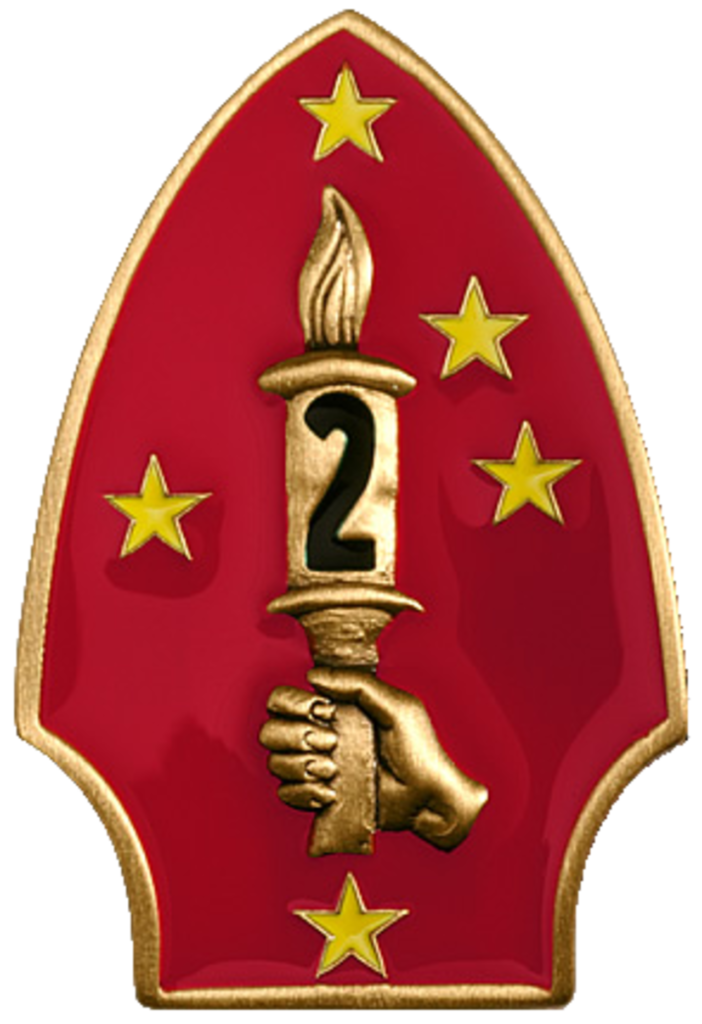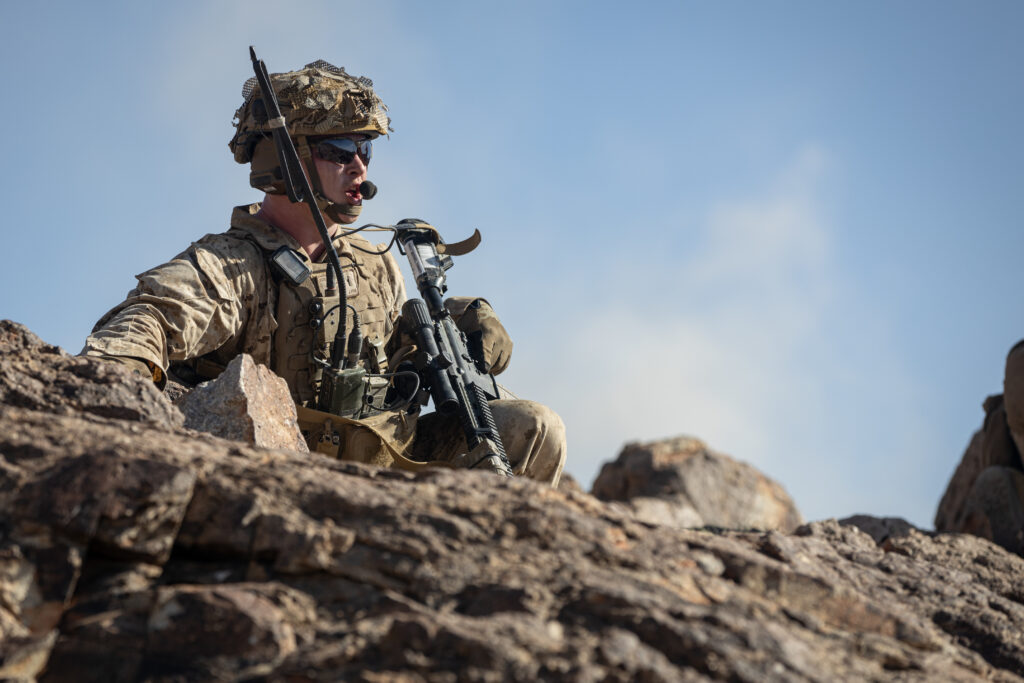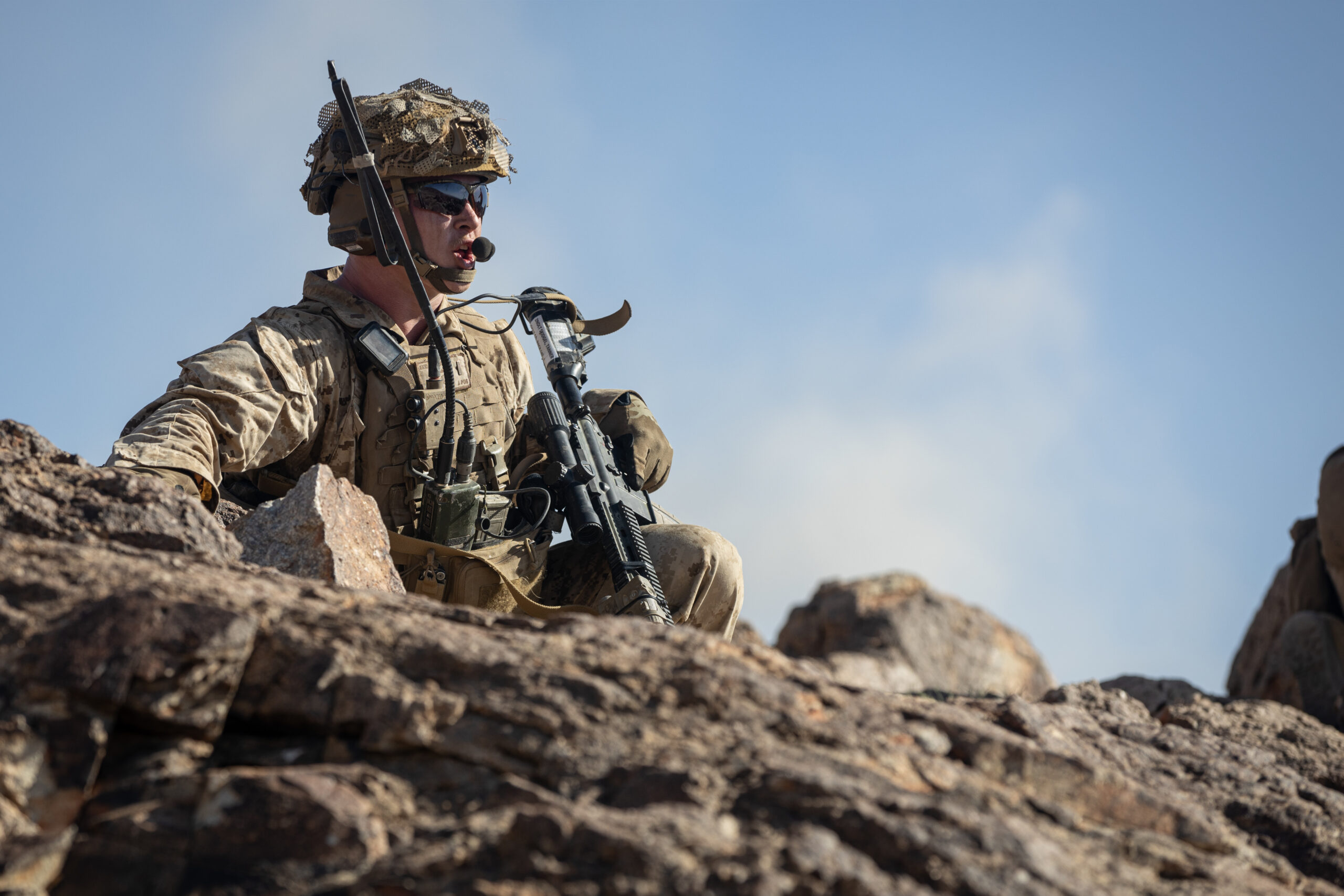When activated at Marine Corps Base San Diego in Feb 1941 to succeed its forebear, the 2nd Marine Brigade (est. 1936), our 2nd Marine Division, “The Silent Second,” consisted of the 2nd, 6th, and 8th Marine infantry regiments; 10th Marines, an artillery regiment; engineer, medical, service, and tank battalions; and transport, signal, chemical, and antiaircraft machine gun companies.

The Journey Through the History of the 2nd Marine Division
During WWII, the 2nd Marine Division (HQ) participated in the Pacific Theater of Operations, including combat and other action at Guadalcanal, Solomon Islands, Tarawa, Gilbert Islands, Saipan, Peleliu, Tinian, Cape Gloucester, Okinawa and Nagasaki (less than a month after the atomic weapon detonation there). Also, in WWII, two Seabee battalions were posted to the 2nd MARDIV; the 18th Naval Construction Battalion (NCB) was assigned to the 18th Marines as the third Battalion of the regiment. The Division did not take part in a major action again until 1958 when elements participated in US intervention during the initial involvement in Lebanon. Its units helped reinforce Guantánamo Bay during the Cuban Missile Crisis in 1962 and landed in the Dominican Republic in 1965 as part of Operation Power Pack. Other peacekeeping operations carried out by the Division include being part of the Multi-National Peacekeeping Force in Lebanon from August 1982 until February 1984. The Division took the loss of 238 Marines and Sailors along with three attached US Army personnel during the 1983 Beirut barracks bombing – the monument in their memory at Lejeune says, “They came in peace.” Toward the end of the 1980s, Division Marines participated in the Operation Cause invasion of Panama. As of 2024, the 2nd Marine Division is composed of Headquarters Battalion; 2nd, 6th, and 10th Marine Regiments; the 2nd Assault Amphibian Battalion; 2nd Combat Engineer Battalion; 2nd Light Armored Reconnaissance Battalion; and the 2nd Reconnaissance Battalion. Between the Banana Wars (ca. 1898-1934) and the War Against the Islamic State (starting 2013), the 2nd MARDIV has technically or literally been active in twelve wars, including approximately sixty-one different named operations. It has had fifty-eight Commanders thus far and has been based at Camp Lejeune, NC, for over eighty years. While the Division was new in 1941, “Second Division” was no new name in Marine Corps history. In WWI, a brigade of Marines served in the US Army 2nd Division, AEF, with Marine officer Maj. Gen. John A. Lejeune as commanding general. Marines TWS lists 3,137 members who have served with this storied unit whose motto is “Follow Me.”

This Division records its current purpose as follows:
“The mission of the 2d Marine Division (2d MARDIV) is to generate, train, and certify forces to conduct expeditionary operations in support of II Marine Expeditionary Force (II MEF) campaign objectives and crisis response tasking. On order, 2d MARDIV will plan and execute Division-level ground combat element operations as part of a Marine Air-Ground Task Force or Naval Expeditionary Force.” Between the lines of such statements, one might imagine the complete roster of Marines ever serving under their emblem and names of the fallen, wounded, and missing throughout the course of decades and dozens of dull duty or intense combat operations. Every unit designation ultimately consists of lineage and history. Lineage usually includes numbers and identifying terms understandable to those familiar with the branch-specific jargon. History, however, encompasses the names of people, the places they were, the exploits of their organization, and the struggles, tragedies, and triumphs fully known only to them. Taken together, lineage and history form an unfathomable picture of the 2nd Marine Division and every other assignment, from lone sentry outside the wire to expeditionary forces landing on windswept sands of lands distant and foreign in every possible sense. At Tarawa, the Division suffered more than 3,200 casualties. At Guadalcanal, the total number of Marines killed was 1,152, along with 2,799 wounded and 55 listed as missing. Marine aviation losses were 55 dead, with 127 wounded and 85 missing. Japanese losses during that same campaign were approximately 14,800 killed or missing in action, while another 9,000 died of wounds and disease. About 1,000 enemy troops were taken prisoner, and more than 600 enemy planes and pilots were destroyed. Marines of the III Amphibious Corps, which included the 2nd MARDIV, counted 16,507 battle casualties, with 2,779 of those killed and 13,609 wounded on Okinawa. The 2nd Division had gone through one of the most intense 72 hours of combat in the history of island warfare at Tarawa, with unit casualties including nearly a thousand dead. The Saipan operation seven months later again took a heavy toll on them, with 5,000 wounded and 1,300 dead.

The battle for control of Iwo Jima lasted 36 days. The final death toll among Marines was 5,931 killed in action, died of wounds or missing in action, and presumed dead; more than twice as many Marines as had been killed in all of WWI. 1,394 Marines gave their lives in Operation Iraqi Freedom and Operation Enduring Freedom. The 2nd Marine Division was deployed to Camp Fallujah, Iraq, as the II Marine Expeditionary Force (II MEF) headquarters in January 2005. It had participated in ground actions during Kosovo, Haiti, Bosnia, Liberia, Dominican Republic, Grenada and Somalia.

Numerous books have been dedicated to the 2nd Marine Division, including such titles as: “Bloody Tarawa…“; “Follow Me!…”; “For God and Country…”; “Heritage Years…”; “Landing in Hell…”; “Returned …” and “Faithful Warriors.” In addition, there are a number of films about or including them, such as: “With the Marines at Tarawa,”; “The Great War,”; “The Pacific War in Color,” and “Sands of Iwo Jima,” as well as several produced by Marine Corps University, Marine Corps Heritage Foundation, 2nd Marine Division Association and the Division itself. It would not be entirely incorrect to state that the number of USMC, federal, state, and local memorials, monuments, and burial sites for, including or related to this Division are practically countless domestically and overseas.
Today’s Marine Corps includes four Divisions, 1st through 4th. Assigned under the 2nd Marine Division are the 2nd, 6th and 10th Regiments. The 2nd infantry regiment (est. 1901) comprises the following infantry battalions and one company: Headquarters Company 2nd Marines; 1st Battalion, 2nd Marines; 2nd Battalion, 2nd Marines; 3rd Battalion, 2nd Marines and 2nd Battalion, 8th Marines. The 6th infantry regiment (est. 1917) consists of four (five during War) infantry battalions and one company: Headquarters Company 6th Marines; 1st Battalion, 6th Marines; 2nd Battalion, 6th Marines; 3rd Battalion, 6th Marines, 1st Battalion, 8th Marines; and 2nd Battalion 9th Marines (during wartime only, when activated). The 10th Marine Regiment (est. 1914) is an artillery regiment composed of Headquarters Battery, 10th Marines; 1st Battalion, 10th Marines; 2nd Battalion, 10th Marines; 3rd Battalion, 10th Marines (disbanded on April 26, 2013); 4th Battalion, 10th Marines (was disbanded); and 5th Battalion, 10th Marines (disbanded on June 1, 2012). Formerly of the 2nd MARDIV, the 8th Marine Regiment (est. 1917) was decommissioned on January 28, 2021. It comprised three infantry battalions and one company: Headquarters Company 8th Marines; 1st Battalion, 8th Marines; 2nd Battalion, 8th Marines; and 3rd Battalion, 8th Marines.

This unit’s honors include:
Presidential Unit Citation Streamer – World War II, Tarawa
China Service Streamer
American Defense Service Streamer with one Bronze Star
European-Africa-Middle Eastern Campaign Streamer
Asiatic-Pacific Campaign Streamer with one Silver Star and Two Bronze Stars
World War II Victory Streamer
Navy Occupation Service Streamer with Asia and European Clasps
National Defense Service Streamer with one Bronze Star
Marine Corps Expeditionary Streamer
Armed Forces Expeditionary Streamers with Two Bronze Stars
Navy Unit Commendation Streamer for Operations Desert Shield and Desert Storm
Southwest Asia Streamer with Three Bronze Stars
The Modern Role of the 2nd Marine Division
Although OPSEC protects specifications, the current activity of the 2nd Marine Division may be included in their general summary of excerpts as follows: “The Marine Expeditionary Unit (MEU) is the smallest of the MAGTFs and comprises about 2,200 Marines and Sailors. Its major elements are the Command Element (CE), the Ground Combat Element (GCE), the Aviation Combat Element (ACE), and the Logistics Combat Element (LCE). The CE comprises the commanding officer and supporting staff – about 200 Marines and Sailors. It provides the overall command and control essential for effective planning and execution of operations and synchronizes the actions of each element within the MEU. Skill sets falling under the command element include administration, intelligence, operations, logistics and embarkation, communications, legal and public affairs. The GCE is built around an infantry battalion and provides the overland combat power for the MEU. Assets inherent within the standard infantry battalion include medium and heavy machine guns, mortars, combined anti-armor teams, and scout snipers. While assigned to the MEU, the unit, designated a Battalion Landing Team, is reinforced with light armored reconnaissance vehicles, tanks, artillery, combat engineers, and assault amphibian vehicles.
The ACE is a composite squadron that provides the MEU medium to heavy lift capability, assault support, and close air support (CAS). Its assets include MV-22 Osprey tilt-rotor aircraft or CH-46 Sea Knight medium lift helicopters, CH-53E Super Stallion heavy lift helicopters, AH-1 Super Cobra helicopter gunships, UH-1 Huey utility helicopters, and AV-8B Harrier jump jets. With a force strength of approximately 500, the ACE includes air traffic control, aircraft maintenance/support, and aviation logistics/supply capabilities.
The LCE, about 250 Marines and Sailors strong, provides combat support such as supply, maintenance, transportation, explosive ordnance disposal, military police, water production and distribution, engineering, medical and dental services, fuel storage and distribution, and other services to the deployed MEU. The LCE allows the MEU to support itself for 15 days in austere expeditionary environments.”
Read About Other Famous Military Units
If you enjoyed learning about the 2nd Marine Division we invite you to read about other Famous Units on our blog. You will also find military book reviews, veterans’ service reflections and more on the TogetherWeServed.com blog. If you are a veteran, find your military buddies, view historic boot camp photos, build a printable military service plaque, and more on TogetherWeServed.com today.

Greetings – I recently acquired a small section of a WW2 Japanese Zero Hinomaru (red meatball) panel that was retrieved following the Marine invasion of Tarawa (Betio Gilbert Is). The piece also bears the name ‘Rodibaugh’ (written in pencil). I’ve been able to find out that Pfc Robert E. Rodibaugh was killed 11/30/44 on Bougainville and is currently listed as MIA. He appears to be one of 7 Marines who went missing during combat on that date. As such – do you know if there is a photograph of Pfc Rodibaugh in your collection? I researched his family chart but there doesn’t seem to be any family members left out there for me to contact. If you do have an image, and can provide me with a copy, please advise the cost of same and how one goes about ordering the photograph. I would like to have an image to go with the piece of the Japanese aircraft. Thanks in advance for any assistant that you can provide. Ken Johnson (retired – 82 years of age).